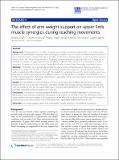| dc.contributor.author | Coscia, Martina | |
| dc.contributor.author | Cheung, Vincent Chi-Kwan | |
| dc.contributor.author | Tropea, Peppino | |
| dc.contributor.author | Koenig, Alexander | |
| dc.contributor.author | Monaco, Vito | |
| dc.contributor.author | Bennis, Caoimhe | |
| dc.contributor.author | Micera, Silvestro | |
| dc.contributor.author | Bonato, Paolo | |
| dc.date.accessioned | 2014-04-24T19:37:18Z | |
| dc.date.available | 2014-04-24T19:37:18Z | |
| dc.date.issued | 2014-03 | |
| dc.date.submitted | 2013-06 | |
| dc.identifier.issn | 1743-0003 | |
| dc.identifier.uri | http://hdl.handle.net/1721.1/86236 | |
| dc.description.abstract | Background
Compensating for the effect of gravity by providing arm-weight support (WS) is a technique often utilized in the rehabilitation of patients with neurological conditions such as stroke to facilitate the performance of arm movements during therapy. Although it has been shown that, in healthy subjects as well as in stroke survivors, the use of arm WS during the performance of reaching movements leads to a general reduction, as expected, in the level of activation of upper limb muscles, the effects of different levels of WS on the characteristics of the kinematics of motion and of the activity of upper limb muscles have not been thoroughly investigated before.
Methods
In this study, we systematically assessed the characteristics of the kinematics of motion and of the activity of 14 upper limb muscles in a group of 9 healthy subjects who performed 3-D arm reaching movements while provided with different levels of arm WS. We studied the hand trajectory and the trunk, shoulder, and elbow joint angular displacement trajectories for different levels of arm WS. Besides, we analyzed the amplitude of the surface electromyographic (EMG) data collected from upper limb muscles and investigated patterns of coordination via the analysis of muscle synergies.
Results
The characteristics of the kinematics of motion varied across WS conditions but did not show distinct trends with the level of arm WS. The level of activation of upper limb muscles generally decreased, as expected, with the increase in arm WS. The same eight muscle synergies were identified in all WS conditions. Their level of activation depended on the provided level of arm WS.
Conclusions
The analysis of muscle synergies allowed us to identify a modular organization underlying the generation of arm reaching movements that appears to be invariant to the level of arm WS. The results of this study provide a normative dataset for the assessment of the effects of the level of arm WS on muscle synergies in stroke survivors and other patients who could benefit from upper limb rehabilitation with arm WS. | en_US |
| dc.description.sponsorship | National Institutes of Health (U.S.) (NIH grant # RC1-NS068103-01) | en_US |
| dc.description.sponsorship | Swiss National Science Foundation (grant PBEZ3_137336) | en_US |
| dc.description.sponsorship | National Institutes of Health (U.S.) (NIH grant # R24HD050821) | en_US |
| dc.publisher | BioMed Central Ltd | en_US |
| dc.relation.isversionof | http://dx.doi.org/10.1186/1743-0003-11-22 | en_US |
| dc.rights | Creative Commons Attribution | en_US |
| dc.rights.uri | http://creativecommons.org/licenses/by/2.0 | en_US |
| dc.source | BioMed Central Ltd | en_US |
| dc.title | The effect of arm weight support on upper limb muscle synergies during reaching movements | en_US |
| dc.type | Article | en_US |
| dc.identifier.citation | Coscia, Martina, Vincent CK Cheung, Peppino Tropea, et al. "The effect of arm weight support on upper limb muscle synergies during reaching movements." Journal of NeuroEngineering and Rehabilitation (2014) 11:22, p.1-15. | en_US |
| dc.contributor.department | Massachusetts Institute of Technology. Department of Brain and Cognitive Sciences | en_US |
| dc.contributor.department | McGovern Institute for Brain Research at MIT | en_US |
| dc.contributor.mitauthor | Cheung, Vincent Chi-Kwan | en_US |
| dc.relation.journal | Journal of NeuroEngineering and Rehabilitation | en_US |
| dc.eprint.version | Final published version | en_US |
| dc.type.uri | http://purl.org/eprint/type/JournalArticle | en_US |
| eprint.status | http://purl.org/eprint/status/PeerReviewed | en_US |
| dc.date.updated | 2014-04-22T03:42:03Z | |
| dc.language.rfc3066 | en | |
| dc.rights.holder | Martina Coscia et al.; licensee BioMed Central Ltd. | |
| dspace.orderedauthors | Coscia, Martina; Cheung, Vincent CK; Tropea, Peppino; Koenig, Alexander; Monaco, Vito; Bennis, Caoimhe; Micera, Silvestro; Bonato, Paolo | en_US |
| mit.license | PUBLISHER_CC | en_US |
| mit.metadata.status | Complete | |
